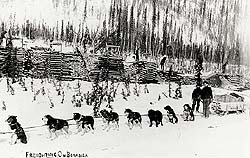 |

 
|
 |
WEIGHT ALLOWANCES FOR DOG-TEAMS
On average, dog-teams pulled sleds carrying mail weighing between 500 and 700 pounds [250 to 350 kilos],44 which meant that each dog would often haul up to 100 pounds [50 kilos] of mail (although they hauled less on more challenging trails).45 As the dogs were also pulling the food, equipment and other necessities required for the trip, the weight of the mail was critical. "Carriers would bring first-class mail, but newspapers, magazines and packages were left behind. Sometimes correspondents slid newspaper clippings and gifts into letters, but if the package was too thick, suspicious carriers would leave it behind for the spring steamboats."46
 |

Freighting on Bonanza Creek, Yukon, ca. 1900
© Public domain
National Library and National Archives of Canada, C-000399
Bonanza Creek, formerly Rabbit Creek, was a tributary of the Klondike River. In August 1896, gold was found in the creek. Panners rushed to the region by whichever route they could find. |
Mail sacks were usually packaged to weigh 50 pounds [25 kilos] each, making it easier for the mail carrier to load and unload his sled. Postmasters and carriers also preferred to use rubber-lined waterproof bags to protect the mail from the snow, rain and mud.47
Pack-dogs also were used to transport the mail. The mail was placed into sacks that hung on either side of the dog's back; a strong dog could carry up to 50 pounds [25 kilos] in these sacks.48

|
 |